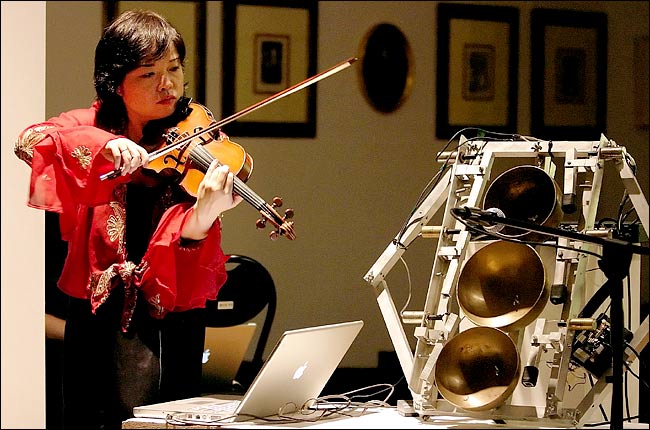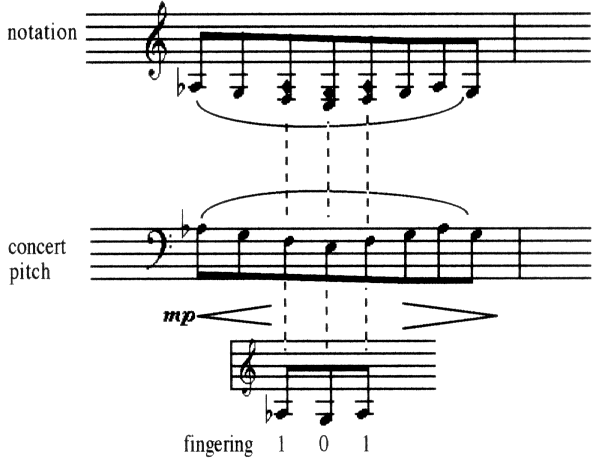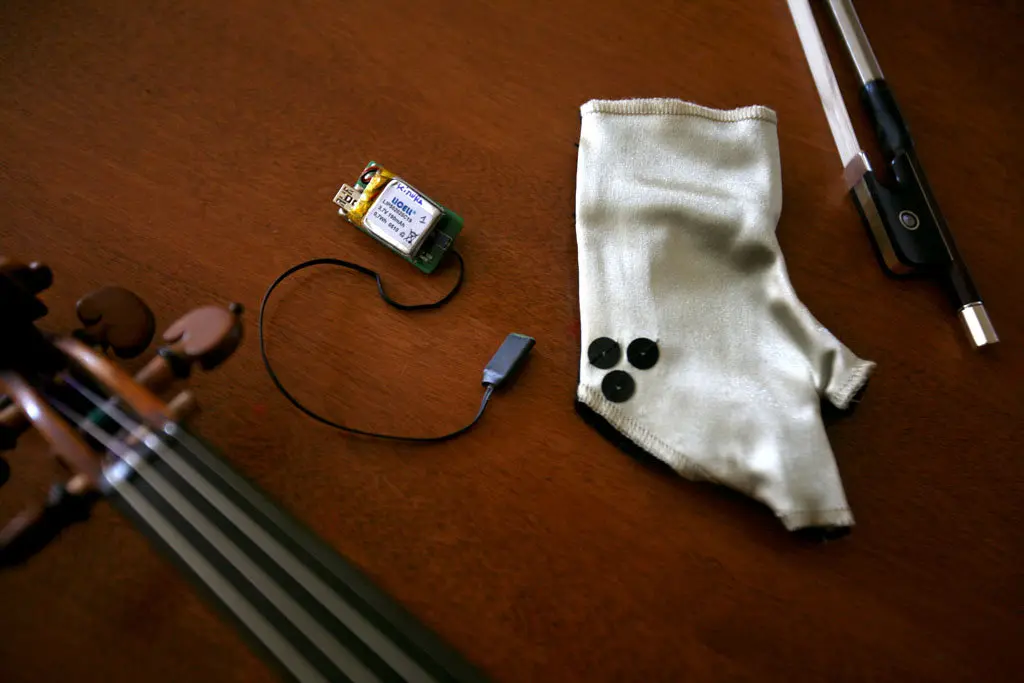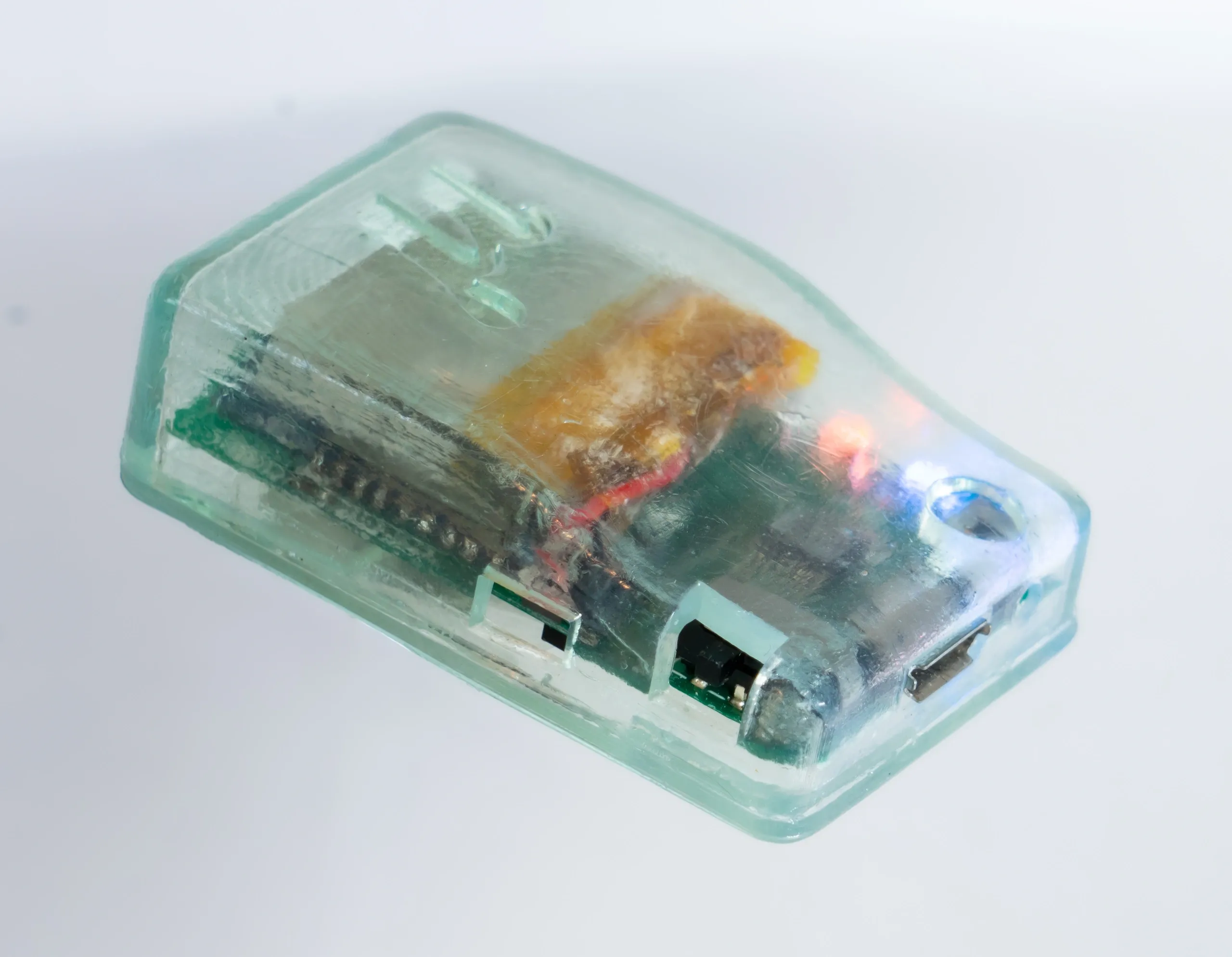Mari Kimura
16 May 2022 - Richard Chong

Mari Kimura playing "Pluck-Ring" with TibetBot, a robot designed to emulate Tibetan singing bowls used by Buddhist monks during meditation
Mari Kimura is an innovative violinist and composer who is well-known for her research in computer-augmented music. On the violin, Kimura is a virtuosic performer and improviser. As a composer, she incorporates her work on the cutting edge of music technology and violin playing in her music. Since 2017, Kimura has been a Professor of Music at UC Irvine's ICIT (Integrated Composition, Improvisation, and Technology) program in the Claire Trevor School of the Arts Music Department. In September 2020, she released her motion sensor, MUGIC, commercially, making it more accessible for musicians to interact with technology during performances.
Mastering the Violin
Mari Kimura was born and raised in Tokyo, Japan. Her mother was an aspiring pianist, a fact that led to Kimura studying violin and piano as opposed to traditional Japanese instruments. As a teenager, she studied under the violinist Armand Weisbord. Kimura earned a Bachelor of Music from the Toho Gakuen School of Music studying violin performance with Toshiya Eto. On Eto's recommendation, she moved to Boston University after graduation to pursue a Master in Music with Roman Totenberg, a friend of her former professor. While studying at Boston University, Kimura had a master class Joseph Fuchs who invited her to study with him at Julliard. Since graduating from Juilliard with a Doctor of Musical Arts, Kimura has premiered many significant works including John Adams's Violin Concerto, Luciano Berio's Sequenza VIII, Tania Léon's Axon for violin and computer, Salvatore Sciarrino's 6 Capricci, and Dai Fujikura's Motion Notions for violin and motion sensor.
While perfecting her skills on the violin, Kimura would discover subharmonics. Her first teacher Weisbord introduced her to many unconventional techniques designed to enhance her violin playing. One of these exercises was a modified version of "Son Filé", where a violinist draws the bow slowly while also applying more pressure. When pursuing her Doctor of Music at Julliard, Kimura noticed faint notes below the note being played while practicing Ravel's Tzigane. This observation led to a moment of inspiration and after two weeks of diligent practice, Kimura developed a clearer understanding of the pressure, placement, and speed of the bow required to produce subharmonics.
Kimura introduced the world to subharmonics through her first composition, ALT. Kimura has since incorporated subharmonics into various other compositions including Gemini for solo violin (1993), "6 Caprices for Subharmonics" (1997-1998), and her cadenza for Jean-Claude Risset's Violin Concerto Schémes (2006-2007).

Becoming a Composer
Composition was not always at the forefront of Kimura's mind. She began to develop a greater interest during her undergraduate years. Many of her friends and classmates were composers whose music she would often play, which inspired her to take more theory and composition classes. It was not until becoming friends with Marvin Minsky during her time at Boston University, however, that she would begin taking the prospect of becoming a composer seriously. Minsky was a professor of both Media Arts and Sciences and Electrical Engineering and Computer Science at MIT who co-founded the MIT Media Lab, a research laboratory dedicated to diverse areas of interest in art, science, design, and technology.
As a requirement for her student visa, Kimura took a course on computers and electronics as a requirement at Boston University. This course exposed Kimura to many examples of music concréte, compositions that utilized recorded sounds. One of the pieces that appealed most to Kimura was Mario Davidovsky's Synchronisms No. 6, a piece for piano and tape. Davidovsky was the Edward MacDowell Professor of Composition at Columbia University, which made it possible for Kimura to take private lessons with him in composition in parallel with her violin studies at Juilliard.
Kimura's experiences have provided her with a unique perspective that shapes the music that she composes. Her music centers around the traditions of the violin while also drawing from her Japanese heritage. However, her compositions almost always feature technology for a modern twist.
Discography
- U (The Cormorant) (1992)
- Futaku for violin and percussion by Yoshihiro Kanno (1993)
- Acoustics with Henry Kaiser, Jim O'Rourke, and John Oswald (1994)
- ECO for violin and signal processing (1996)
- Irrefragable Dreams with Robert Dick (1996)
- Leyendas with Roberto Moralez Manzanares (2000)
- Polytopia (2007)
- Third Eye Orchestra by Hans Tammen (2008)
- Mari Kimura Redux by Noah Creshevsky
- The World Below G and Beyond (2010)
- Full Moon by Mari Takano
- Particle Ensemble with Earl Howard, Tom Buckner, and J.D. Parran (2012)
- Active Figurations for violin and computer by Rai Takayuki (2013)
- Harmonic Constellations (2016)
- Voyage Apollonian (2017)
Program Notes and Interview by the Vilcek Foundation
A Vibrantly Developing Career
Beyond her initial years of education, Kimura has continued to enjoy a fruitful career as a soloist and composer. Her work in music technology has also flourished.
In 2008, Kimura began working with the Sound Music Movement Interaction Team at the Paris Institute for Research and Coordination in Acoustics/Music (IRCAM) on Modular Musical Objects (MO). This project focused on creating a wearable, wireless sensor that could track the motion of a violinist's bow arm. Later on, she designed her own Augmented Violin glove that was finalized into the form factor featured below.

Mari Kimura's most recent Augmented Violin Glove as redesigned by Mark Salinas
Searching for a way to make sensors for music more accessible, Kimura began collaborating with Liubo Borissov to create an Arduino 9-axis DIY sensor known as MUGIC. Working with engineers in Calit2, Kimura would hone this prototype into the MUGIC that is purchaseable today.

Most recent model of MUGIC
To share her experience and knowledge about the music technology, she became the Founding Chair of the Future Music Lab at the Atlantic Music Festival in 2013. This love of teaching can also be seen in her work as Assistant Professor at New York University, Graduate Faculty at the Juilliard School, and Professor of Music at UC Irvine, where she regularly teaches and advises students in the ICIT program.
From beginning of her tenure at UC Irvine in July of 2017, Kimura has been the president of Kimari, LLC, the company behind the commercialization of the MUGIC device. To support her entrepreneurial pursuits, Kimura has recently enrolled in the Executive MBA Program at UC Irvine, a track designed for professionals who already possess comprehensive work and management experience.
Awards
- 1995 Kenzo Nakajima Music Prize
- 2010 Guggenheim Fellowship in Music Composition
- 2010 Composer in Residence at IRCAM (Institute for Research and Coordination in Acoustics/Music) in Paris
- 2011 Fromm Commission Award from Harvard
- 2011 Carnegie Corporation Great Immigrants Recipient
- 2014 Composers Now Creative Residency at the Rockefeller Brothers Fund
- 2020 UCI Innovator Awards nomination
- 2020 United States House of Representatives Certificate of Congressional Recognition
Other Resources
- Mari Kimura's own website
- Mari Kimura's Linkedin Page
- Mari Kimura's article on subharmonics published by the Journal of New Music
- Interview by David Bundler
- The Julliard Journal's Faculty Portrait
- iWKCR-FM Columbia University Radio Interview
- The Magnitude of Mari Kimura: Prolific Composer and Academic